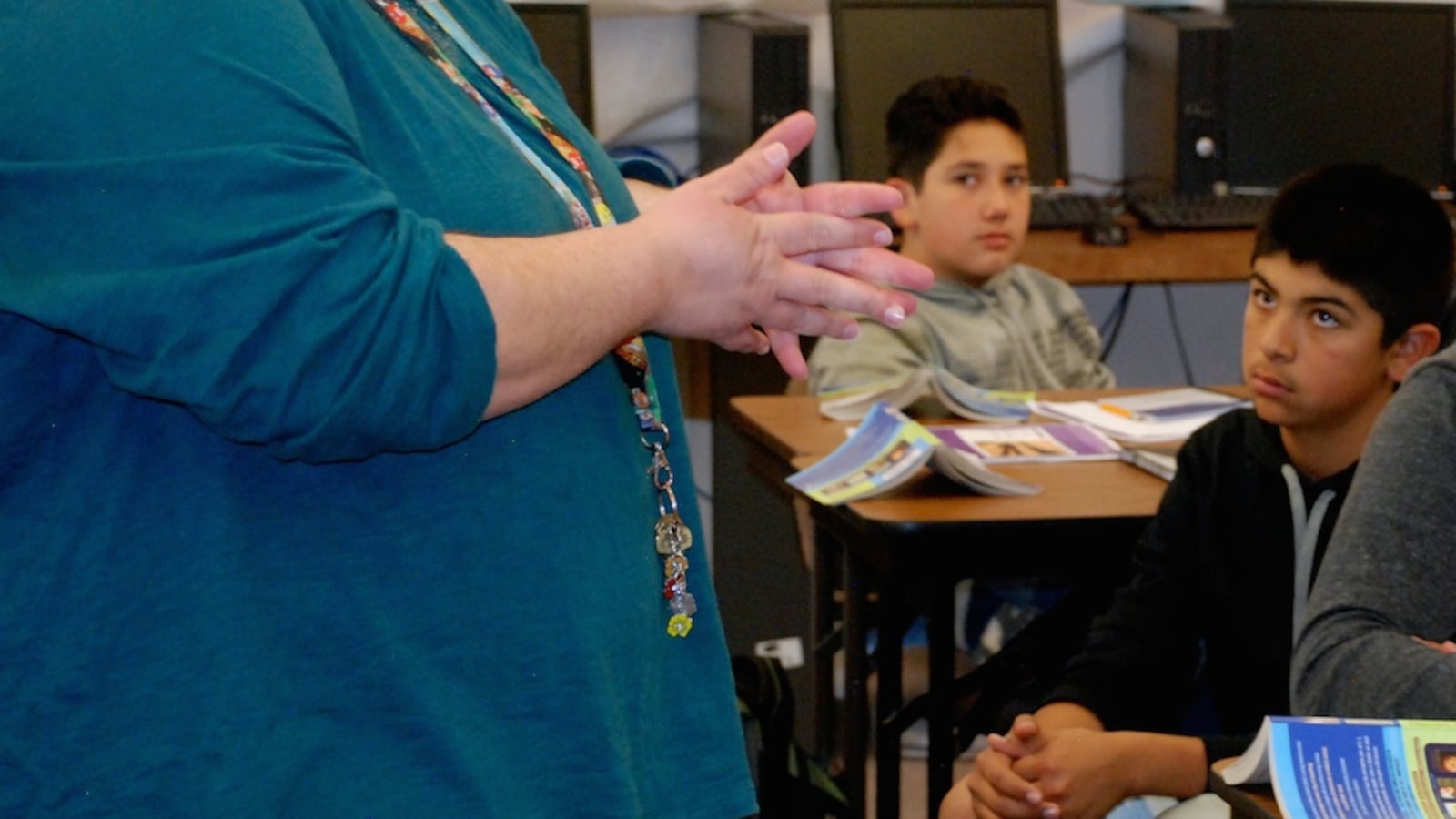The end of a three week unit on characters, plots, and themes is near in Leslie Fitzgerald’s eighth grade reading class at the Pueblo School of Arts and Sciences. On Thursday students began reading their last short story, “With Bert and Ray, told by William,” in a collection Throwing Shadows by E.L. Konigsburg.
The charter school class is using the anthology of short stories to understand the most basic literary techniques. These lessons may seem strikingly similar to lessons of yesteryear, even though this is the first year schools are supposed to be teaching to a new set of standards. For some Colorado districts, the new standards have meant a complete instructional overhaul.
But at this Pueblo arts and sciences school, teachers began exploring the standards in 2010 and found that in most subjects they had to make only slight shifts, said Natalie Allen, head of school.
Fitzgerald’s students are a bit excited after returning from a districtwide choir competition. As they tumble into their seats and unpack their shared tubs of books, reading journals, and workbooks, Fitzgerald reads aloud to them. The story of “Bert and Ray” begins with the narrator explaining his family’s current plight: His father has died of alcoholism and his mother, known as “Ma,” has been left with plenty of debt, including two months of dentist bills.
Fitzgerald usually begins the group reading aloud, she said after the lesson. “I want the students to hear fluent reading.” It also helps ensure that all students are in the same place when the class breaks for discussion. And it doesn’t take Fitzgerald long before she’s prodding her students about unfamiliar vocabulary words and themes.
To pay off the dentist bills, William tells the readers, Ma has decided to have a garage sale. William’s father was a bit of a pack rat and collected guns and other hunting paraphernalia including duck decoys. Fitzgerald stops to ask her students if they know anyone like William’s father. Does anyone in your family collect obscure objects? The students nod and Fitzgerald shares her own experience of a family member collecting hundreds of National Geographic magazines.
A common reading instruction technique is to ask students to connect the text they’re reading to their own personal lives. However, Fitzgerald says, part of an instructional shift aligned to the new Colorado Academic Standards requires students to go beyond personal connections and connect what they read to other texts. She does this next.
As the story continues, Ma has priced all the items and opened her home to buyers. Among her first customers is a pair of antique collectors, Bert and Ray. The collectors offer Ma exactly what she asked for the decoy ducks and are quickly on their way. Bert and Ray tell Ma to invite them back whenever she has another sale — they’ll be there.
Fitzgerald stops again to ask her students what that might mean. Several students suggest Ma might have priced the decoys too low. Fitzgerald affirms their inferences. Despite devaluing the decoy ducks, Ma and William make enough money to pay off their dentist bills and get more work done.
One day, on their way home from the dentist, William recognizes Bert and Ray’s shop by a sign hanging outside. The sign includes the word “proprietor,” which Fitzgerald stops to quiz the class on. “What does proprietor mean?” she asks the class. One student suggests it means “expert.” That’s a good guess, Fitzgerald said, but not quite. “What other clues from the text might be useful?”
Prepackaged vocabulary tests, as part of the Success For All literacy curriculum the school uses, have become increasingly more complex, Fitzgerald said after the lesson. In earlier editions of the program, students might have been asked to choose words from a bank to fill in sentences. Now, they might have to come up with a word on their own or find words being misused in sentences. The vocabulary tests are now three times as long.
William suggests he and his mother visit Bert and Ray, as the collectors had instructed them to do if they were ever near the shop. But Ma doesn’t want to. She believes it’s rude to “pay a call unexpected.” Fitzgerald stops here, after reading aloud for 15 minutes. What does that tell you about Ma, she asks? How does she compare to other adults in the previous short stories we’ve read, asks Fitzgerald?
Critics of Colorado’s new standards have often criticized what they say is an emphasis on shorter stories and non-fictional texts, as opposed to longer classic novels. But Fitzgerald said she has used novels and short stories interchangeably for years. She said using short stories makes it easier for students to draw comparisons and contrast themes and symbols as they begin exploring those literary devices.
After a brief discussion on Ma, Fitzgerald asks her students to stop and predict what will happen when William and Ma enter Bert and Ray’s shop. She also assigns the majority of what’s left in the short story, pages 122-136, for partner reading. It might seem like a lot for independent and partner reading, she said, but she assures her students they can do it. Her students will have a unit test next week.

